Abstract:
Granulated blast furnace slag (S) Granulated blast furnace slag is made by rapid cooling of a slag melt of suitable composition, as obtained by smelting iron ore in a blast furnace and contains at least two-thirds by mass of glassy slag and possesses hydraulic properties when suitably activated. Granulated blast furnace slag shall consist of at least two-thirds by mass of the sum of calcium oxide (CaO), magnesium oxide (MgO) and silicon dioxide (SiO2). The remainder contains aluminium oxide (Al2O3) together with small amounts of other compounds. The ratio by mass (CaO + MgO)/(SiO2) shall exceed 1,0.
The WDXRF instrument was setup with the fusion calibration method for the accurate and precise oxide analysis of slag.
The slag needs to conform to the EN 197-1 International norm to be used as an extender in king CEMII Portland Slag cement , CEM III Blast Furnace cement and CEM V Composite cements.
In order to lower the carbon footprint and reduce CO2 the clinker produced is used to produce more extended cements.
The kiln is fired with alternative fuels to make clinker that is more cost effective.
The more alternative fuels used to make cement, the lower the carbon footprint X-ray fluorescence is used to show new ways of reducing CO2.
Biography:
Carmen worked for PPC Cement from the period of 2000 to 2019, as a Research Chemist then a Senior Chemist and as an XRF Specialist. She has 19 years of working experience.
The work done at PPC cement entailed application support on all XRF instruments in the Group.
Quality assurance is required at all production sites to be able produce accurate and reliable analytical data for process control. In order to achieve this, she ensured that sample preparation for all X-ray fluorescence (XRF) follows best operating practices, calibration curves on the XRF instruments are matrix matched and minerologcally representative of the materials used in the process.
She conducted reviews on XRF, sample preparation and quality best operating methods throughout all PPC plants, ranging from inland, costal and International sites located in other African countries.
Previous positions held have been as a Senior Chemist and later Research Chemist in the Chemistry Reference Laboratory at the ISO 17025 Accredited Group laboratory Operations.
Her knowledge and vast experience is on working with various types of XRF instruments ranging from Energy Dispersive, Wavelength Dispersive, Sequential and Simultaneous Spectrometers.
Carmen has extensive knowledge and experience in other analytical techniques including ICP-MS, ICP-OES, XRD, FTIR Ion Chromatography and general wet chemistry. Her problem solving skills and analytical knowledge in XRF spectrometry, wet chemistry analysis and sample preparation methods is key to providing much needed technical support to the Group on various different types of analytical equipment used for testing various materials in the cement industry.
She also provided software support to the Group on the XRF instrument types, ranging from Thermo , PAnalytical, Bruker and Rigaku.
She provided training (XRF spectrometry, wet chemistry and sample preparation best practices) to the Group Quality personnel. Carmen is a dedicated hard worker who pays attention to detail and possesses strong analytical skills. Currently Carmen is the XRF Application Scientist for Rigaku. The support is provided to International customer under the EMEA countries.




